Brent Fenty is the wildlands coordinator for the Oregon Natural Desert Association, an organization that has worked for over a decade to protect, defend, and restore Oregon’s native deserts.

Monday, 17 Feb 2003
BEND, Ore.
I am practicing my Monday morning ritual. After taking my dog, Kenai, out to run in a nearby field, I am in the office bright and early to update our website and ease into the week before the phones begin ringing and the staff starts elbowing past each other on the way to the printer, filing cabinets, and fax machine. Today is bound to be particularly busy as we prepare for a town-hall meeting with Oregon Sens. Ron Wyden (D) and Gordon Smith (R).

ONDA’s cozy headquarters.
ONDA’s office is a testimony to the Keynes-inspired mantra, “Getting your nickel’s worth.” We occupy the eastern wing of the second floor of the Central Oregon Environmental Center; our total floor space is less than 300 square feet. In this area, we manage to stuff five staff members, complete with desks, filing cabinets, printers, phones, a resource library, and, occasionally, three dogs. Welcome to the cozy world of environmental nonprofits.
ONDA is a grassroots organization that has spent over a decade working to protect, defend, and restore Oregon’s native deserts. Yep — for those of you who didn’t know, approximately two-thirds of Oregon is desert. Although Oregon does have the vast playas and shifting sand dunes the public commonly associates with deserts, most of the state’s high desert is covered by sagebrush. The region is home to national treasures such as Steens Mountain, Hart Mountain National Wildlife Refuge, Malheur National Wildlife Refuge, the Deschutes River, the John Day River, and the Owyhee Canyonlands.
Recently, a lot of the website updates I’ve worked on have focused on efforts to restore grey wolves to Oregon. Wolves, which were once part of the Northwest’s intricate web of life, have not been spotted in Oregon for over 50 years. During the early 1900s, the federal government employed “wildlife agents” and paid settlers to hunt and trap wolves — and, for good measure, any other predators they could find. These hunters and trappers were frighteningly efficient. By the mid-1900s, wolves were extirpated from the western United States. Today, wolves remain a missing link in Oregon’s ecosystem.
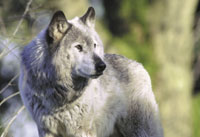
A grey wolf.
Beginning in 1995, with overwhelming national support (a 1998 National Wildlife Federation poll indicated that 76 percent of Americans support wolf recovery), the U.S. Fish and Wildlife Service successfully reintroduced wolves into Yellowstone National Park and central Idaho. Since then, wolves have gradually expanded their range.
Over the past few years, at least three wolves have returned to Oregon, only to be deported or killed. With wolf populations growing in Idaho, Montana, and Wyoming, wolves will continue to return to Oregon. During the past several months, the debate has grown over whether Oregon officials should allow wolves to stay.
Since the reintroduction of wolves in Idaho, Montana, and Wyoming, livestock predation has been well below predicted levels and no human being has been attacked by wolves. Despite these facts, ranchers like Oregon Cattleman’s Association member Sharon Beck continue to throw around hyperbole like, “Howling wolves may sound nice when you’re sitting at home in front of the TV, but when you’ve got nothing between you and hungry wolves but a thin wall of canvas, it’s scary.”
Conflicting with this kind of politically-driven exaggeration is the fact that less than a few dozen livestock are lost annually to wolves. For comparison’s sake, in Montana alone, more than 200,000 livestock are lost every year to causes ranging from lightning strikes to domesticated dogs. In addition, the public is not hiding from wolves. On the contrary, thousands of intrigued Americans have flocked to see wolves in the wild over the past several years and some guides now make a tidy profit leading wolf-viewing trips.
Groups like ONDA are working to ensure that wolves are allowed to naturally recover within the state and that future generations have the privilege to hear wolves once again howling throughout Oregon’s wilderness.
As far removed as wolves seem from fingers tapping on a keyboard, this morning’s website update is a small part of this larger effort to return wolves to Oregon. Today, I am updating a form that allows the public to provide comments directly to Oregon’s Fish and Wildlife Commission via ONDA’s website.
So now is your chance! If you want to learn more about welcoming wolves back to Oregon or send a message supporting the recovery of wolves in the state, visit our website.
As for me, I’m off to Wyden and Smith’s town hall meeting to advocate for wolves and Oregon’s unprotected desert wilderness.
Tuesday, 18 Feb 2003
BEND, Ore.
Last night, after recuperating from a local town hall meeting with Oregon Sens. Ron Wyden (D) and Gordon Smith (R), I finished reading Nothing Like It in the World, Stephen Ambrose’s book about the building of the transcontinental railroad. A quote from a foreman on the Union Pacific Railroad, Dan Ferguson, struck me as particularly prescient. Ferguson wrote in his diary in the summer of 1868 that, “The time is coming and fast too, where in the sense it is now understood, there will be no west.”
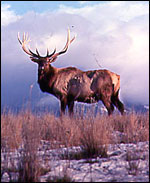
Bull elk at the Badlands.
This is a sentiment that was never far from the minds and hearts of many of the settlers who displaced natives, both humans and wildlife, as they made the West their new home. Fortunately, their conquest of the West was not entire. There are still pieces of the former world left for us to preserve and cherish.
It is my own belief that wildlands are what bind together the generations — past, present, and future. As a kid, I remember hunting deer near Awbrey Butte and the West Hills of Bend, Ore. These areas seemed far from town at the time. Today, both areas are subdivisions well within the city limits. In my short life, it is astonishing to witness such change, but my tale is hardly unique. Similar stories are eerily common throughout the west.
As I listen to my elders tell stories about little-known wild places throughout Oregon’s High Desert, I am reminded of how important these lands are. The Badlands, an area just 15 miles east of Bend, is one such remnant wildland — and although the possibility of a war on Iraq was appropriately the most common topic at last night’s meeting, the Badlands was also discussed. Supporters wearing bright orange “Protect Badlands Wilderness” stickers packed into the auditorium at a local high school, prompting Smith to comment, “I see a lot of orange stickers around the room today; I guess that means you want us to work on wilderness.”
Ironically, like many of the other remaining wilderness areas in the U.S., the Badlands remains wild simply because no one wanted to claim it — and those who did failed in their attempt to bend it to their will. Like Brussels sprouts pushed to the side of a dinner plate, these lands are our least-wanted, our leftovers.
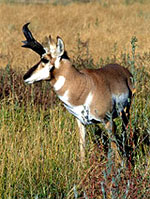
Pronghorn antelope.
Nevertheless, places like the Badlands have become increasingly valuable as our country becomes overwhelmed by growth and development. Amid the expansion of urban areas like Bend, the Badlands serves as habitat for a variety of species — mule deer, Rocky Mountain elk, pronghorn antelope, prairie falcons, American kestrels, gopher snakes, sagebrush lizards, American badgers, long-tailed weasels, and a variety of bats, to name just a few. The area is also host to Native American pictographs, unique geologic formations known as inflated lava, and a dose of peace and tranquility that is ever valuable to us as humans.
The Badlands is an area that activists have sought to protect as wilderness for nearly two decades. Wilderness status would close the area to off-road vehicles, thereby mitigating defacement of archeological and cultural sites, garbage dumping, and the illegal cutting of juniper trees that are over 1,000 years old.
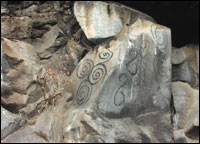
Pictograph vandalism.
Protection would be incredibly timely. Only two weeks ago, several Native American pictographs were vandalized, at least one of them so thoroughly that it is lost to us forever. Fortunately, details of the pictographs had been recorded and a local archaeologist, perhaps searching for some consolation, commented, “The documentation allows us to know what we have lost.”
Despite a recent push by a diverse coalition of local ranchers, businesses, landowners, and conservation groups, the Badlands still remains unprotected. Through the collective efforts of past, present, and future generation, this area could be Oregon’s newest desert wilderness. If you have a couple of moments, you can send a fax from our website urging Oregon’s Congress members to protect this spectacular area. Or, if you want to go all out, give them a call. Here are their phone numbers:
Ron Wyden: 202-224-5444
Gordon Smith: 202-224-3753
Rep. Greg Walden (R): 202-225-6730
As Olaus Murie once proclaimed, “God bless America, let’s save some of it!”
Wednesday, 19 Feb 2003
PORTLAND, Ore.
I’m writing this journal entry as I speed northward on Highway 97. No, I haven’t taken multi-tasking to new levels. Fortunately for me and everyone else on the road, Bill Marlett, executive director of Oregon Natural Desert Association, is driving.
A few wispy clouds are fading on the eastern horizon this morning, while to the west, the Cascade Mountains are buried in denser, darker clouds. My fingers are crossed that the mountains are squeezing some ever-precious moisture out of the sky. This winter has been particularly mild and, at this rate, Oregonians are in for a very dry summer.
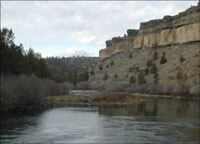
Deschutes River Canyon.
Today’s destination is Portland, where desert wilderness activists from all over Oregon are converging to discuss current and future desert-protection efforts. Participants vary from large national groups like the Wilderness Society to small, grassroots organizations like ONDA. No matter their size, these organizations all share a vision of over 6 million acres of federally-designated wilderness in Oregon’s high desert.
Although the meeting requires a three-hour drive, Bill and I have the benefit of some spectacular scenery. We are currently crossing the Deschutes River and entering the Warm Springs Indian Reservation. As a steelhead- and trout-fishing devotee, I crane my neck to pick out any sign of fish in the waters below, but I spot nothing. Nothing, I should say, except a beautiful and powerful river that, over millions of years, has created impressive columnar basalt-lined canyons.
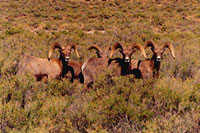
Bighorn sheep.
Sadly, in many cases, the Deschutes River’s loveliness is only skin deep. Despite the river’s grandeur, it has been subjected to numerous abuses over the past century. Salmon and steelhead that were once common in the river no longer reach their traditional spawning grounds due to the building of the Pelton-Round Butte Dam in 1959. Bighorn sheep, which were once native to the Deschutes River Canyon, disappeared during the past century due to over-hunting and disease from livestock.
Despite these injustices, there is hope. In the past several years, bighorn sheep have been reintroduced to the Deschutes and other areas throughout Oregon’s high desert. Currently, there is an effort underway to return steelhead and sockeye and chinook salmon to their traditional spawning grounds above the dam. More good news: Two years ago, a large area along the Deschutes River was acquired to ensure the preservation of fish and wildlife habitat.
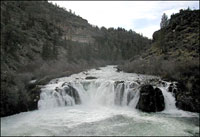
Since the dam was built, steelhead and salmon no longer return to Steelhead Falls.
Today in Portland, we will talk about how to preserve those 6 million acres, including portions of the Deschutes River Canyon. Specifically, we will discuss a desert wilderness inventory that was conducted by dozens of volunteers last year and covered over 750,000 acres of public lands.
These and other efforts give me hope that we will succeed in preserving Oregon’s remaining desert wilderness area. Perhaps we will also succeed in re-wilding areas like the Deschutes River, which hold so much potential for the sustenance of Oregon’s native biodiversity.
Thursday, 20 Feb 2003
BEND, Ore.
Today, among other things, I am preparing to teach a class on Steens Mountain at the local community college. The class covers a range of topics, from natural history to conservation politics. This evening’s two-hour session will focus on the U.S. Congress’s decision, in 2000, to designate Steens as the nation’s first cow-free wilderness.
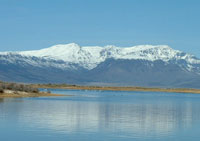
Steens Mountain, with Borax Lake in the foreground.
Steens Mountain has towered over Southeast Oregon for nearly a million years, according to geologists. That actually makes it a spring chicken as far as mountains go, but of course, much of the rock and dirt that forms it has been here much longer — millions and even billions of years. As the land was forced upward by geologic forces, glaciers were created that gradually carved away significant parts of the mountain. Today, we are left with a national treasure and a sight that dazzles thousands of visitors each year.
In 1999, one of those visitors was then-Secretary of Interior Bruce Babbitt. After standing atop the summit of Steens Mountain and looking out over the vast Alvord Desert some 5,000 feet below, he declared that he believed the area worthy of National Monument status.
Local ranchers, never ones to be told what to do by the federal government (although always happy to be the beneficiaries of extensive federal subsidies), opted to cut a deal with conservationists, resulting in the nation’s first Cooperative Management and Protection Area. This designation created a 500,000-acre area that is closed to off-road vehicle use, geothermal and mineral development, and includes 175,000 acres of federally designated wilderness.
Three years later, questions of what it all means still abound. Stakeholders continue to argue over interpretations and priorities. Tonight, I’ve invited aides from the offices of Oregon Sen. Ron Wyden (D) and Rep. Greg Walden (R) to share their understandings of what the designations mean, as well as their visions for the mountain’s future.
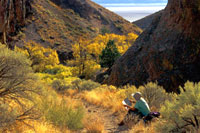
A hiker takes a break near Pike Creek.
If prior classes are any indication, a few students will be intrigued by the discussion but most will be daydreaming about their favorite spots on Steens. Maybe a hike up to the “eyes” of Pike Creek, or a picnic atop the overlook at 2,000-foot-deep Kiger Gorge, or fly fishing on the Blitzen River with three gorges and a 10,000 foot snow-capped mountain towering in the background.
Like these students, most folks avoid the politics of conservation — and understandably so. It is a slow and painful process. Efforts to protect Steens began over three decades ago and still the work is only partially complete. Most of us don’t want to spend our time fighting to protect these areas; we want to spend our time enjoying them. Such is the conundrum.
This class is one of many ways in which ONDA provides education that will hopefully build a love of Oregon’s high desert and an understanding of what it takes to protect these places for future generations. If only one or two of the people in the class become desert wilderness activists, it will be time well spent.
Friday, 21 Feb 2003
BEND, Ore.
Today is one of those days that reinforces that mine is a dream job. Fresh off a late night teaching a class about Steens Mountain, I am off with Laurel Hickok, ONDA’s assistant wildlands coordinator, and Mark Hanschka, a volunteer and capable pilot, to fly over Steens Mountain and the Owyhee Canyonlands as part of ONDA’s Wilderness Research and Rescue Project.
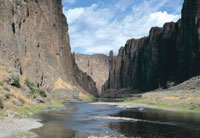
Owyhee River.
Today, Ma Nature has blessed us with infinite blue skies and mind-bending visibility. Taking off, we fly over Newberry Volcanic National Monument; soon after passing over Paulina Peak, we get a glimpse of Steens Mountain on the horizon, over 100 miles to the east. Behind us the numerous snow-capped peaks of the Cascade Mountains overlook Oregon’s dry side — a landscape with some of the largest tracts of unprotected wilderness in the lower 48.
Oregon’s desert lands, characterized by sage-steppe and juniper forest ecosystems, are concentrated in the southeast but can be found throughout the state east of the Cascade Range. Most of these lands are owned by the public and managed by the Bureau of Land Management, the nation’s largest landlord.
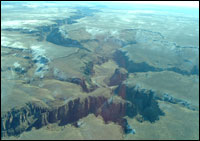
Birds-eye view of the Owyhee canyonlands.
Oregon contains approximately 13.4 million acres of publicly-owned desert land. ONDA’s staff and volunteers have determined that over 6 million acres of this land qualify as wilderness, but less than half are currently protected under that designation or as a Wilderness Study Area. Under federal wilderness inventory and study procedures, the BLM is required to consider any new information suggesting that an area qualifies as wilderness. The purpose of ONDA’s Wilderness Research and Rescue Project is to organize citizens to inventory BLM lands in Oregon that are currently unprotected, and to document and submit information outlining which of those lands meet federal guidelines for wilderness.
Last year, which was the first year of the project, we focused on public lands throughout the Andrews Resource Area, which includes spectacular areas such as Steens Mountain, the Alvord Desert, the Pueblo Mountains, the Sheepshead Mountains, and the Trout Creek Mountains. The effort involved over two dozen volunteers and led to the documentation of wilderness values on over 750,000 acres of public lands. The inventory results were compiled into a 400-page report with over 1,500 photos, which we then submitted to BLM for consideration. The BLM has accepted the report and is currently using it to develop transportation and wilderness recommendations for nearly 1 million acres of public land.
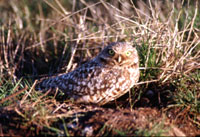
Burrowing owl.
Today, we are flying over some of the areas we recommended for wilderness last year as well as areas in the Owyhee Canyonlands region that we plan to inventory this summer. The Owyhee region, overlapping into Idaho and Nevada, is the largest unprotected roadless area in the lower 48 states. It is home to rare fish, wildlife, and plant species, including the world’s largest herd of California bighorn sheep, sage grouse, song birds, redband trout, longnose snakes, rare pygmy rabbits, and seven species of bats. The area also contains unique geologic features and innumerable archeological and historical sites.
Right now, we are flying from the headwaters of the West Fork of the Owyhee to where it joins the main branch of the Owyhee River just south of Three Forks. The view from the plane dwarfs the canyon walls below, which tower a thousand feet over the river in some places. This is a perspective that is new for me and my heart leaps as my mind recognizes places where I have stood before. At the same time, I am overtaken by awe of how much country is spread before me; enough country that it would take a lifetime to investigate every crack and crevice.
This is part of every American’s natural heritage. It is one of the few remaining places where a person could easily forget that there ever was an industrial revolution. This is wilderness as envisioned by Congress when it passed the Wilderness Act in 1964 to “assure that an increasing population, accompanied by expanding settlement and growing mechanization, does not occupy and modify all areas within the United States.”
It is difficult to fathom that the thread of river below is a part of the extensive and elaborate whole known as the Columbia River Basin. The Owyhee River, which in the not-so-distant past supported runs of salmon, makes its way north through these spectacular canyons before joining with the Snake River and then the Columbia River on its voyage to the sea.
Thanks to the hard work of dozens of volunteers and activists, I’m confident this area will become wilderness in my lifetime. If you are interested in lending a hand, I hope to see you on a Wilderness Research and Rescue trip this summer. More information is available on ONDA’s website. Happy trails.

